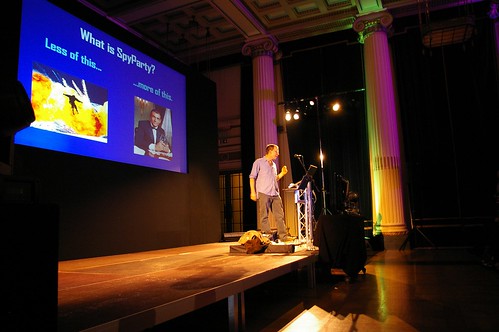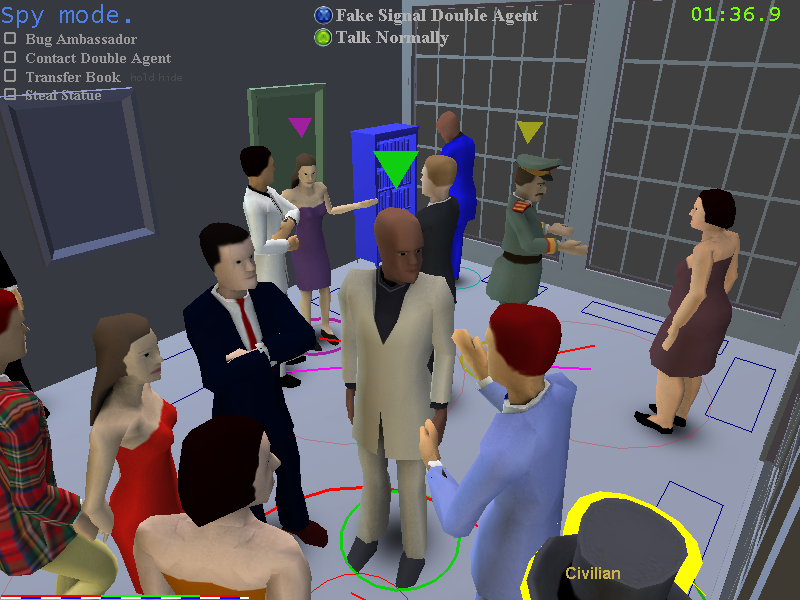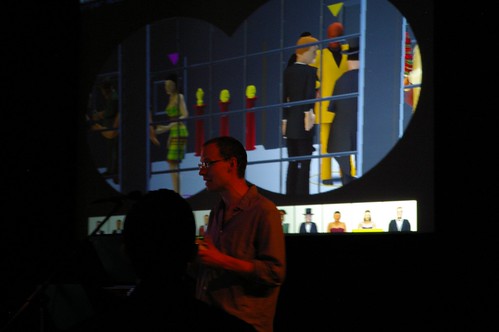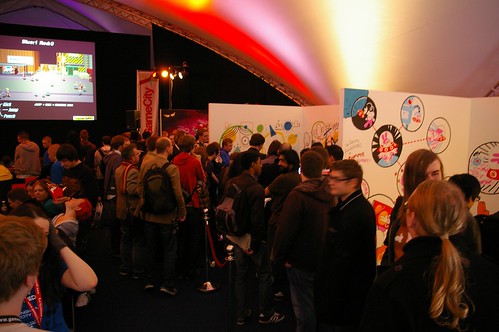Today - for me at least - was all about Spy Party. It was no longer even Thursday anymore: it was Spy Party day.
Okay, in fairness I did enjoy the Guardian Breakfast session. If there's one thing I will say about how well the GameCity days appear to be structured, it's that themes appear to tie together - I don't know if that's planned or whether the delegates and attendees subconsciously come back to common themes together. The Guardian Breakfast neatly discussed the potential for video games to mature as a medium and some discussion about the sought-after 'emotional response' to video games.
Players and indie developers seemed to be in some agreement that the more interesting responses to a game come out of emergent game-play, rather than relying on the writer of a cut-scene or the direction of plot to elicit a reaction in the same way in which film or television achieves it.
I suggested that some of the best reactions I have had to games has been down to an attachment to the characters. I cited Cannon Fodder as a case in point. Squaddies arrive with a unique name and for as long as they survive, they progress through the ranks and their skills improve. A kind of attachment is made with these figures which means that when they take an injury and begin bleeding to death a genuine dilemma is faced as to whether to relieve them of their misery. Other gamers, too, cited the naming of squads in UFO as a key part of the attachment. There is no 'writing' emotion into these attachments (much as that pains someone like me!); it is a case of providing the space in which these attachments can be formed and then providing the catalyst for a drama in microcosm.
So the theme in my head for the day was: response to games and characters on a psychological and instinctive level, rather than a utilitarian approach to characters and avatars as 'resource.' This ties in very neatly with The Big Thing, namely Spy Party.
Okay, in fairness I did enjoy the Guardian Breakfast session. If there's one thing I will say about how well the GameCity days appear to be structured, it's that themes appear to tie together - I don't know if that's planned or whether the delegates and attendees subconsciously come back to common themes together. The Guardian Breakfast neatly discussed the potential for video games to mature as a medium and some discussion about the sought-after 'emotional response' to video games.
Players and indie developers seemed to be in some agreement that the more interesting responses to a game come out of emergent game-play, rather than relying on the writer of a cut-scene or the direction of plot to elicit a reaction in the same way in which film or television achieves it.
I suggested that some of the best reactions I have had to games has been down to an attachment to the characters. I cited Cannon Fodder as a case in point. Squaddies arrive with a unique name and for as long as they survive, they progress through the ranks and their skills improve. A kind of attachment is made with these figures which means that when they take an injury and begin bleeding to death a genuine dilemma is faced as to whether to relieve them of their misery. Other gamers, too, cited the naming of squads in UFO as a key part of the attachment. There is no 'writing' emotion into these attachments (much as that pains someone like me!); it is a case of providing the space in which these attachments can be formed and then providing the catalyst for a drama in microcosm.
So the theme in my head for the day was: response to games and characters on a psychological and instinctive level, rather than a utilitarian approach to characters and avatars as 'resource.' This ties in very neatly with The Big Thing, namely Spy Party.
As suggested my day pretty much ran like this, for the most part:
- Attend Chris Hecker talk in which he introduces Spy Party
- Go to Working Lunch to hear Chris Hecker (and others) talk about being an indie (and therefore Spy Party)
- Queue for Spy Party hands-on alpha
- Interview Chris Hecker about Spy Party while queueing for Spy Party
- Play Spy Party hands-on alpha
- Think about Spy Party
- Go to find a toilet and then somehow get knackered trying out EA Sports Active 2
- Think about Spy Party

The premise which Chris Hecker gives us for Spy Party is that most games about spies revolve around shooting and action whereas culturally what we associate with spies and great spy fiction is "they're acting cool and hiding in plain sight."
He describes a game in which he wants the action and the source of the drama to revolve around players exercising "perception versus deception and performance". He first identifies what we consider to be main gamer skills as: "map navigation, aiming & shooting, micro-management and combat strategy" whereas he wants to create a game in which the player is challenged in "behaviour perception, subtle performance, playing it cool and social pattern matching."
Chris Hecker is clearly an excited evangelist of his game. Watching him speak he gives the impression that not only is he convinced he has created a game which fulfills these aims but that he is only beginning to scratch the surface of how cool these things will eventually be in the final game. "I want people with limited gaming experience but people skills to totally own traditional game players."
The dynamic of the game as it currently stands has one player as the spy at a party full of recognisable spy-movie characters. The player is one of these random characters and must complete a series of objectives: bug the ambassador, steal a statue, move a microfilm and signal a double agent.
The second player? Sniper. Sole aim is to identify and assassinate the other player, by identifying their behaviour in a room crowded with AI.
"Spy Party uses violence in a filmic way. It's the threat of violence, really ... used to add drama or tension to the scene." The threat of assassination, visible to the spy player as the floating laser beam of the sniper's scope not only provides the player with clues as to where the sniper is looking at that moment, but is also an ever-present reminder of failure.
Hecker describes the game as a "reverse Turing test." The famous Turing is designed to see if an AI program can fool a human into thinking that they are talking to a person. In this game the model is turned on its head to see if a human player can emulate the actions of the Non-player characters.
After the session I managed to grab Chris' attention for a quick question. Given that human beings are very adept at pattern recognition and spotting human-like movements, how is it that the player's movements are not immediately distinguishable from that of the AI? "They use the same pathing," he explains. The player controls the character directly, but it moves along the same routes available to the AI.
As stated, we were in familiar company for the Working Lunch discussion with Chris Hecker, among others, talking about the drive to make games from an Indie perspective.
What came across from the panel was a deep desire to make truly personal games and to have the creative freedom to hold onto a game until it has been crafted into the 'right' shape, rather than having to meet deadlines for a company.
When the afternoon came with the chance to get hands-on with Spy Party a huge queue demonstrated the massive interest this game has already generated:
The queue was very painful, although the pain was lessened once in sight of the monitors as it became a real pleasure to watch players trying their hand at both the sniper and spy roles and seeing how people took to this different type of gaming.
It was a great opportunity and a real honour to be able to play the game at such an early stage, especially given how protectively indie creators can feel over their personal projects and was definitely worth the play. I confess totally to failing as both the spy and the sniper.
Big thanks to Chris Hecker for all of this and also or providing me with an interview so good I'm going to have to write a separate article once the festival is finished in order to do it justice!
 Photos used courtesy of GameCity and Spy Party screenshot from developer website. Images used with big thanks and permission.
Photos used courtesy of GameCity and Spy Party screenshot from developer website. Images used with big thanks and permission.
He describes a game in which he wants the action and the source of the drama to revolve around players exercising "perception versus deception and performance". He first identifies what we consider to be main gamer skills as: "map navigation, aiming & shooting, micro-management and combat strategy" whereas he wants to create a game in which the player is challenged in "behaviour perception, subtle performance, playing it cool and social pattern matching."
Chris Hecker is clearly an excited evangelist of his game. Watching him speak he gives the impression that not only is he convinced he has created a game which fulfills these aims but that he is only beginning to scratch the surface of how cool these things will eventually be in the final game. "I want people with limited gaming experience but people skills to totally own traditional game players."
The dynamic of the game as it currently stands has one player as the spy at a party full of recognisable spy-movie characters. The player is one of these random characters and must complete a series of objectives: bug the ambassador, steal a statue, move a microfilm and signal a double agent.
The second player? Sniper. Sole aim is to identify and assassinate the other player, by identifying their behaviour in a room crowded with AI.
"Spy Party uses violence in a filmic way. It's the threat of violence, really ... used to add drama or tension to the scene." The threat of assassination, visible to the spy player as the floating laser beam of the sniper's scope not only provides the player with clues as to where the sniper is looking at that moment, but is also an ever-present reminder of failure.
Hecker describes the game as a "reverse Turing test." The famous Turing is designed to see if an AI program can fool a human into thinking that they are talking to a person. In this game the model is turned on its head to see if a human player can emulate the actions of the Non-player characters.
After the session I managed to grab Chris' attention for a quick question. Given that human beings are very adept at pattern recognition and spotting human-like movements, how is it that the player's movements are not immediately distinguishable from that of the AI? "They use the same pathing," he explains. The player controls the character directly, but it moves along the same routes available to the AI.
As stated, we were in familiar company for the Working Lunch discussion with Chris Hecker, among others, talking about the drive to make games from an Indie perspective.
What came across from the panel was a deep desire to make truly personal games and to have the creative freedom to hold onto a game until it has been crafted into the 'right' shape, rather than having to meet deadlines for a company.
When the afternoon came with the chance to get hands-on with Spy Party a huge queue demonstrated the massive interest this game has already generated:
The queue was very painful, although the pain was lessened once in sight of the monitors as it became a real pleasure to watch players trying their hand at both the sniper and spy roles and seeing how people took to this different type of gaming.
It was a great opportunity and a real honour to be able to play the game at such an early stage, especially given how protectively indie creators can feel over their personal projects and was definitely worth the play. I confess totally to failing as both the spy and the sniper.
Big thanks to Chris Hecker for all of this and also or providing me with an interview so good I'm going to have to write a separate article once the festival is finished in order to do it justice!
 Photos used courtesy of GameCity and Spy Party screenshot from developer website. Images used with big thanks and permission.
Photos used courtesy of GameCity and Spy Party screenshot from developer website. Images used with big thanks and permission.

Hi, just wanted to say that I'm really happy I found this article (through being retweeted by SpyParty)! It's so well written and (I imagine) it will make perfect future reference... particularly as I have been pretty much only stewarding at GameCity so far.
ReplyDeleteThanks for covering SpyParty (and your other GameCity posts) and as soon as the feature works again I will find some way of following this blog...